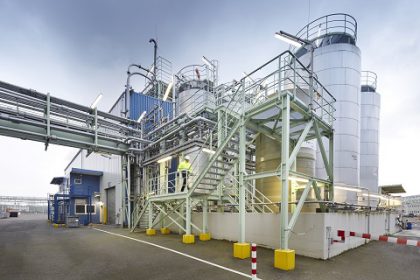Clariant will continue to power its BU Additives production facility in Knapsack, Germany, solely with 100% renewable electricity following the site’s successful pilot switch one year ago.
This underlines Clariant’s continued efforts of shifting to the use of renewables for its electricity demand, lowering the impact on climate change.
The site in Knapsack is home to four plants dedicated to the production of environmentally-compatible flame retardants. Clariant’s halogen-free Exolit products provide fire protection to buildings, transport, electrical components and appliances, electronic devices and furniture applications around the world. Many carry Clariant’s EcoTain® label in recognition of their outstanding sustainability-related advantages.
Knapsack’s 100% changeover to electricity sourced from water and wind power is confirmed by Unbundled Energy Attribute Certificates. The switch was undertaken as part of the site’s and Clariant’s commitment to reduce Scope 2 greenhouse gas emissions – indirect emissions from consumption of electricity. It represents just one aspect of the wider business unit- and company-wide transition to more sustainable production and a reduced carbon footprint. This also includes the sourcing of renewable raw materials as feedstock. Clariant is aiming to reduce energy consumption by 30% and direct and indirect greenhouse gas emissions by 35% by the year 2025 (baseline 2013).
At Knapsack specifically, by switching to renewable electricity, 7300 t CO2 emissions are estimated to be avoided annually, based on planned annual electricity demand. Further, the site has introduced ethylene from renewable resources as a feedstock option for the new range of Exolit OP Terra flame retardants. “Terra” highlights renewable feedstock products with at least 50% Renewable Carbon Index (RCI) content based on renewable resources with a mass balance certification or real renewable content. Exolit OP halogen free flame retardants are the first to be based on renewable sources and proven to be recyclable as confirmed by Fraunhofer LBF. By offering Terra solutions and using renewable raw materials Clariant will further lower greenhouse gas emissions over the product life cycle.
Stephan Neunerdt, Head of Production & Technology Flame Retardants, BU Additives, Clariant comments: “Green electricity is already part of Clariant’s energy mix in facilities in Poland, Sweden and beyond. The Additives production facility in Knapsack is the first location in Germany to join the group in leading Clariant’s transition towards using renewable electricity. Knapsack is another example to demonstrate the feasibility for industrial manufacturers to take a holistic approach to reducing their environmental impact, carbon footprint and dependency on fossil resources, from energy consumption to raw material use.”
Stephan Lynen, Head of BU Additives, Clariant adds: “We are committed to expanding the use of renewable and reusable resources in our procurement, production and commercial system while reducing the resource consumption. Our commitment to sustainability is without alternative.”
Knapsack carries REDcert2 certification – confirmed by TÜV Nord – which recognizes the site’s mass balance based use of renewable ethylene as an alternative to fossil-based feedstock for specific products.
The last article about “Clariant” published at “Polymer Industry Media International” was: Clariant’s Catalysts Business Unit Opens Third Location For Engineering Services












